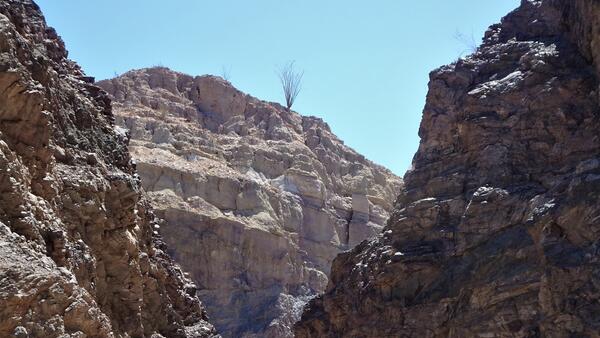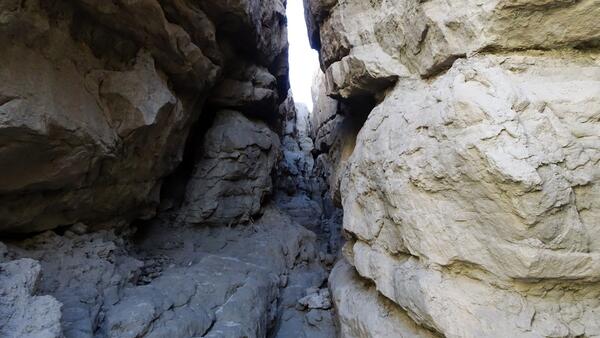Take a walk back in time
“A million years is a short time - the shortest worth messing with for most problems. You begin tuning your mind to a time scale that is the planet's time scale. For me, it is almost unconscious now and is a kind of companionship with the earth.” ― John McPhee, Basin and Range
We often have trouble with the power of time, especially what we might call “deep time,” spans that encompass not decades, or even centuries, but thousands and millions, and thousands of millions of years. We are good with hours, days, years, maybe a lifespan, maybe even the time since humans have banded together into what we call civilization. However, to understand the patterns we see today, patterns of biodiversity and patterns of mountains, we need to think in deep time. That is as true with deserts as with any landscape. So, let’s take a walk back in time.
+30,000,000 years ago: The Peninsular and Transverse Mountain Ranges produce the rain shadow that in turn limits winter rains from reaching their leeward side, creating the Colorado and Mojave Deserts. These ranges are the result of the Farallon Plate subducting below the North American Plate, causing magma to rise and forming a chain of volcanoes – the same process that maintains the still active volcanoes in the Cascade Range of Oregon, Washington, and southern British Columbia. This process began more than 100,000,000 years ago. Eventually the portion of the Farallon Plate slamming into the California coast became fully subducted, shutting off the magma feeding the volcanoes. As the inactive volcanoes eroded, their cooled and crystalized magma cores, batholiths, comprised of intrusive igneous granitic rock, became exposed. Then, maybe 30,000,000 years ago those granitic batholiths began slowly uplifting, creating an ever more efficient rain shadow. That slow, ongoing process allowed plants and animals to adapt to these increasingly arid conditions, shift to habitats more suitable to their energetic needs, or perish. In addition, some tropical species began shifting northward, taking advantage of a warm climate and a general abundance of open spaces, relatively free of the intense competition they faced in dense tropical forests. Among those tropical immigrants were cacti, which then radiated into the many cactus species we find so well adapted to life in our deserts.
5,000,000 years ago: About this time, the late Miocene to early Pliocene Epochs, the Colorado Plateau had uplifted sufficiently to then have a profound impact on the evolution of our deserts. The Colorado Plateau, a region encompassing northern Arizona, northern New Mexico, and southern portions of Colorado and Utah, uplifted due to remnants of the Farallon Plate subducting further east below the North American Plate, causing magma to rise, resulting in the bulging upwards of the earth’s crust to form the mountain ranges and volcanic activity of that entire region. The higher elevations shifted, causing watersheds that had previously flowed southeast to now flow southwest. Those waters coalesced into what is now the Colorado River. As that early Colorado River “searched” for a path to the ocean, it encountered rock obstacles; before the river could break through each rock mass a large shallow lake would form until the river would burst through. One such obstacle and then break through created the Grand Canyon. The eroded sands of the Grand Canyon were spread across the deserts when the next rock obstacle was encountered; those sands then formed “islands” of sand dunes across the central and eastern Mojave Desert, sand dunes that became the home of Mojave fringe-toed lizards and a host of other plants and arthropods that evolved to thrive in a sand dune habitat. Further along the river’s path Grand Canyon sands were deposited in the Salton Trough during the repeated fillings of Lake Cahuilla. Those sands then formed the Algodones Sand Dunes, home of the Colorado Desert fringe-toed lizard, again fostering the evolution of other dune adapted plants and animals. Finally, the Colorado River reached the ocean at the head of the Gulf of California, and there deposited what was left of the eroded Grand Canyon sands, forming the Gran Desierto sand dune field, the largest expanse of sand dunes in North America. Here again, these dunes provided habitat for the Yuman Desert fringe-toed lizard, and again, other dune adapted taxa. Of the six recognized western species of fringe-toed lizards, the Coachella Valley species is the only one that occupies sand dunes that were not originally eroded from the walls of the Grand Canyon. Coachella Valley sands originate from the granite core of San Gorgonio Mountain.
About the same time as the Colorado River began its path to the ocean, approximately 5-6 million years ago, the ocean intruded up into the Salton Trough. Called the “Imperial Sea,” this was an extension of the proto-Gulf of California north to what is now the western Coachella Valley. At its full intrusion, had there been anyone to experience this, they could have watched whales swimming within sight of what would become Palm Springs. This occurred before North and South America were connected at the isthmus of Panama, and so the marine fossils (scallops, sand dollars, oysters, and a whale) associated with the Imperial Sea are taxonomically tied to the animals that now occur in the warm Caribbean Sea, not the cooler Pacific Ocean. Eventually, through the ongoing floods from the Colorado River, the deposition of eroded Grand Canyon sands into the Salton Trough created what was in effect an earthen dam at the south end of Lake Cahuilla which blocked the connection to the proto-Gulf of California, eliminating the connection to the ocean and the remaining Imperial Sea dried up.
20,000 years ago: The earth’s northern hemisphere was nearing the end of the most recent climate oscillation, the last glacial maximum of the 2,000,000-year span of the Pleistocene Epoch. The ancestors of the Cahuilla were likely to have been there to witness at least these most recent changes. Continental ice sheets a mile or more thick that had extended south far enough to have smothered what are now the northern tier states of the U.S. were just beginning to retreat. Animals and plants that could escape the ice wall had been shunted into the southern latitudes of North America, experiencing an oscillation between warmer and cold climates that was repeated up to ten times during the Pleistocene. During each shift from cold to warmer climates, a transition that may have taken 50,000 – 75,000 years, more desert-like conditions prevailed. During the cold cycles the California deserts were not so desert-like. Rather, they were likely oak, walnut and fan palm savannas (all fossils that have been excavated from the Anza Borrego badlands). The on-going flooding of the Colorado River would have resulted in large expanses of wetland habitats. What are now hyper-arid landscapes would have then supported giant tortoises and herds of mammoths, camels, horses, ground sloths, peccaries, and large carnivorous cats. With warmer and drier conditions, cold-adapted plants and animals either shifted up into our mountains, found refugia in perennial springs along earthquake faults (i.e. current fan palm oases), returned to northern latitudes, or perished. The conifer forests that cloak the tops of our desert mountains, our “sky islands”, are refugees from one or more of those Pleistocene climate shifts.
10,000 years ago: The Cahuilla people were here, or at least their ancestors were. Their population ebbed and flowed with the erratic flooding of the Colorado River. Floods jumped the river’s banks flowing into the lowest elevation, 236 feet below sea level in the Salton Basin or Trough and formed Lake Cahuilla. Once the lake filled to what was approximately the elevation of the sea in the Gulf of California, the river returned to its banks and continued its flow into the ocean. Floods occurred maybe once or twice a century, although the last complete filling of the Salton Trough was probably in the late 1400s. When Lake Cahuilla filled it was a cornucopia for the Cahuilla people. Abundant fish, nesting fish-eating birds, and fresh water. The Cahuilla population likely swelled during those times of plenty, but when the lake dried, the Cahuilla likely returned to the canyons, palm oases, and in summer, moved up to higher elevations to escape the heat and harvest acorns.
200 years ago: The Cahuilla people continued their occupation and stewardship of the Coachella Valley; the Serrano, Chemehuevi, and Mojave tribes occupied deserts to the north and east. California was not yet a state, that would happen in 1850. Because there were no significant gold deposits, and water was limiting, the Spanish, followed by Mexico, and then colonists from the eastern U.S. largely ignored the California deserts. That spared the indigenous people here from the slavery imposed upon other tribes by the Spanish mission system or the forty-niners in their lust for riches in the gold fields of the Sierra Nevada foothills. Nevertheless, the Cahuilla were eventually relegated to Congressionally designated reservations in 1875. Grizzly bears roamed the mountains bordering the desert. Those bears were the largest known south of Alaska, but the last of their kind were shot in the early 1900s. No black bears ventured where those Grizzlies roamed; the current black bear population is descended from 28 bears introduced into the southern California mountains from Yosemite Valley between 1933-1938.
100 years ago: Compared to today, California deserts were a bit cooler, a bit wetter in winter, and not quite so hot in summer. A few wetter than average decades encouraged ranchers to settle in the Mojave Desert, allowing their cattle to range freely beneath the Joshua trees. Later, when the more typical drought conditions resumed, ranching proved to be far less than profitable. Freezing winter temperatures were commonplace, whereas today in the Coachella Valley such frosty temperatures are almost non-existent. The Hoover Dam would not be completed until 1935; the Colorado River was still a wild, free-flowing river. The delta of the Colorado River, as it entered the upper Gulf of California, was believed to be the richest wildlife habitat perhaps in all of North America. Tens of thousands of acres of willows, cottonwoods, and mesquite supported herons, egrets, storks, deer, native fish, mountain lions, and likely jaguars. The waters of the delta were also rich, providing habitat for the totoaba, a fish that reaches sizes of more than two meters and 200 pounds, and a miniature dolphin called the vaquita. Both species are on the verge of extinction today. Commercial agriculture boomed in the Imperial Valley thanks to the completion of the All-American canal built in 1905, siphoning water from the Colorado River. The Coachella canal would not be completed for another quarter century, bringing that same level of industrial-scale agriculture to the Coachella Valley. The 100 square miles of sand dunes that carpeted the Coachella Valley floor from Snow Creek to Indio were still largely intact; today just 5% of those dunes remain. The only impediment to sand flow was the railroad, built across the Coachella Valley in 1876. Otherwise, clusters of development hugged the southern edge of the valley, south of the Whitewater River’s path.
Making sense of the world around us, of the changes that have happened and are ongoing, requires an appreciation of time. Deep time.
Nullius in verba Go outside, tip your hat to a chuckwalla (and a cactus), think like a mountain, and be safe.

